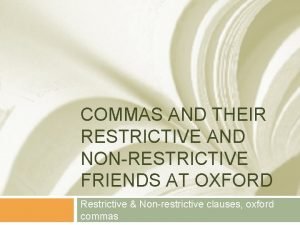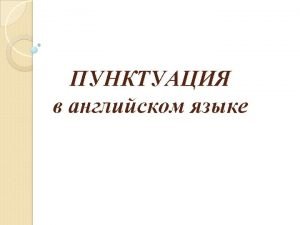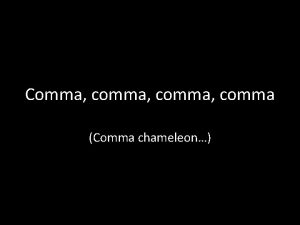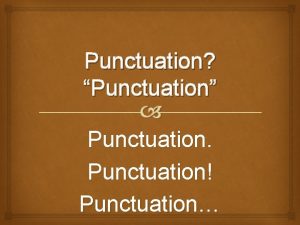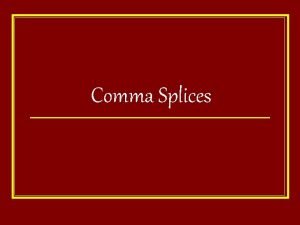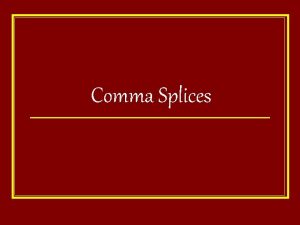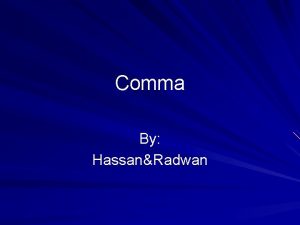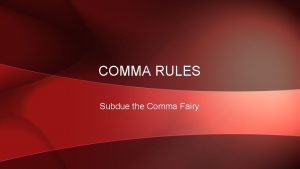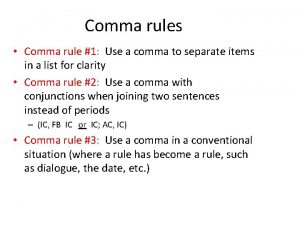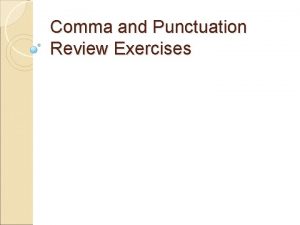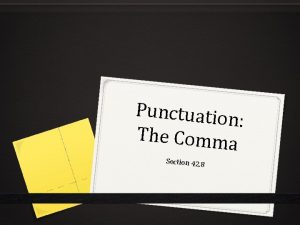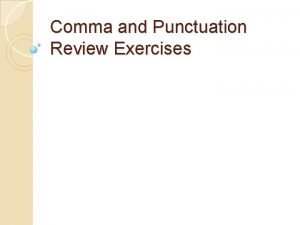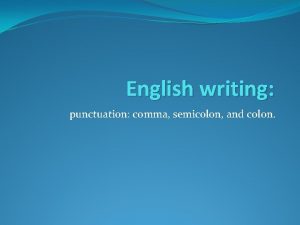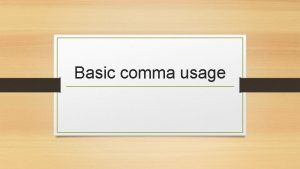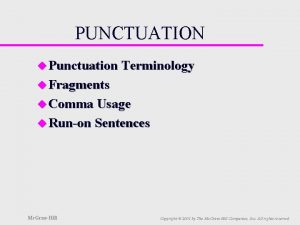PUNCTUATION June 2011 Punctuation The Comma is used














- Slides: 14

PUNCTUATION June 2011

Punctuation The Comma is used to separate parts of a sentence from one another. Commas, when used correctly, make your sentences clear and help in comprehension. Use a comma with these sentence rules: 1. Before a coordinating conjunction (fanboys) that joins two INDEPENDENT clauses. EX: The girl was sick, so she could not go to school. Her house was old, and the windows were broken.

Punctuation 2. To separate three or more items in a series. EX: Fishing, hunting, and camping are his favorite hobbies. It snowed in Omaha, Iowa, and Kansas City. Some writers choose not to use the comma before the coordinating conjunction in a series however, sometimes it can cause confusion in the reader: EX: She packed all of her serving pieces, silverware and bowls.

Punctuation 3. To separate two or more adjectives that modify the same noun when they are not joined by a coordinating conjunction. EX: The tall, smart girl sits in the back of the room. I drove the small, rusty car to California The student was a sweaty, shaky, panicky mess. These sentences do not work, why? The child bounced the bright, green ball.

Punctuation 4. To separate introductory words, phrases, and clauses from the rest of a sentence EX: Above, the sky was bright and clear. When the bell rang, the students found their desks. A comma is not needed if there is no chance of confusion EX: Then a car ran the stop sign.

Punctuation 5. To set off a nonessential clause from the rest of a sentence. A nonessential clause describes a specific word or phrase in a sentence, but does not change the meaning or understanding of who or what is being modified. Mr. Hall, who ordered another double anchovy pizza, claims to have a pet dolphin in his backyard pool. Which man among the billions of human males on the planet? Mr. Hall! The man who ordered another double anchovy pizza claims to have a pet dolphin in his backyard pool. Which man among the billions of human males on the planet? The one who ordered the double anchovy pizza!

Punctuation 6. To set off parenthetical expressions or transitional words that begin the sentence. EX: Therefore, the boy was grounded for two weeks. EX: Horses, for example, usually only have one foal at a time.

Punctuation 7. Dates, addresses, titles, and numbers EX: We start school on August 4, 2011. We start school in August 2011. We start school on August 4, 2011, in Omaha. EX: 485 Albert Way, Petaluma, CA 94952. EX: The Instructor was Jen Lambert, Ph. D. EX: The child counted to 10, 000.

Punctuation 8. Direct quotations EX: The old woman asked, “What is taking so long? ” EX: “Not too much longer, ” the child answered.

Punctuation Do Not Use a Comma: 1. Between a subject and a verb 1. 2. Between a single adjective and the word it is describing 1. 3. I need a blue, dress for the dance. Between two dependent clauses 1. 4. Jen, was startled when the baby screamed. The children began to cry after lunch, but not after nap. Right next to other punctuation 1. “Why doesn’t she like me? , ” the girl demanded.

The Semicolon A semicolon indicates a stronger pause than a comma but not as strong as a period. A writer would use a semicolon: To join two closely related independent clauses. Ex: Call me tomorrow; I will give you my answer then. To join two independent clauses linked by a transitional expression. Ex: My students are very well behaved; therefore, they will pass the class. To separate items in a series if commas are already used within the items. Ex: I’ve lived in Petaluma, CA; Salt Lake City, UT; and Omaha, NE. Use the semicolon between two sentences joined by a coordinating conjunction when one or more commas appear in the first sentence. Ex: When I finish here, I will be glad to help you; and that is a promise I will keep.

Common Grammar Errors Use a lot, not alot (Note: This is a vague phrase. Can you be more specific? ) Its is a possessive noun. Example: Its windows are made of glass. It’s is a contraction of “it is. ” Example: It is a lovely day outside.

Common Grammar Issues Their is plural and possessive. Example: Their house is always spotless. There refers to a particular place. Example: Please put the bowl over there. They’re is the contraction of “they are. ” Example: They’re a very nice couple.

Common Grammar Errors Do your nouns and verbs agree in tense and number? Check for homophones, words that sound alike but mean different things. Examples: affect/effect accept/except principal/principle
 Comma comma comma chameleon meme
Comma comma comma chameleon meme Full stop punctuation
Full stop punctuation Quá trình desamine hóa có thể tạo ra
Quá trình desamine hóa có thể tạo ra Khi nào hổ mẹ dạy hổ con săn mồi
Khi nào hổ mẹ dạy hổ con săn mồi Các châu lục và đại dương trên thế giới
Các châu lục và đại dương trên thế giới Các loại đột biến cấu trúc nhiễm sắc thể
Các loại đột biến cấu trúc nhiễm sắc thể Nguyên nhân của sự mỏi cơ sinh 8
Nguyên nhân của sự mỏi cơ sinh 8 Bổ thể
Bổ thể Phản ứng thế ankan
Phản ứng thế ankan Thiếu nhi thế giới liên hoan
Thiếu nhi thế giới liên hoan Vẽ hình chiếu vuông góc của vật thể sau
Vẽ hình chiếu vuông góc của vật thể sau Hát lên người ơi
Hát lên người ơi điện thế nghỉ
điện thế nghỉ Một số thể thơ truyền thống
Một số thể thơ truyền thống Hệ hô hấp
Hệ hô hấp
